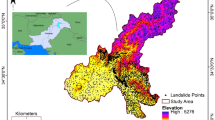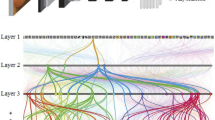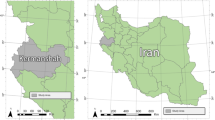Abstract
In mountainous regions subjected to landslides, susceptibility mapping of these geohazards is necessary for averting and alleviating perilous dangers. The present study applies an integrated methodology for assessing landslide susceptibility of northern Pakistan (Mansehra and Muzaffarabad districts). Three orthodox machine learning (ML) classification techniques, including support vector machine (SVM), logistic regression (LR), and random forest (RF), are integrated with convolutional neural network (CNN) used. For training and testing of the models, spatial datasets consisting of 3251 sites of historical slopes are used in a ratio of 70:30. Initially, a total of 16 influencing factors for landslide modelling were established. The training dataset specifically constructs three hybrid models CNN-SVM, CNN-LR, and CNN-RF. Then, final susceptibility maps (LSMs) will be built using these trained models. These models will be implemented. For having a comparison, the LSMs are also prepared using the considered ML models individually. In the end, multiple statistical methods are used to validate and compare the performance of these models. The results of the analysis have revealed the efficiency of applying the projected ML models by combining them with the CNN technique. Therefore, in other sensitive regions with comparable geo-environmental conditions, the future hybrid designs can be used effectively for landslide susceptibility studies.












Similar content being viewed by others
Change history
15 September 2021
A Correction to this paper has been published: https://doi.org/10.1007/s00500-021-06249-4
References
Aditian A et al (2018) Comparison of GIS-based landslide susceptibility models using frequency ratio, logistic regression, and artificial neural network in a tertiary region of Ambon, Indonesia. Geomorphology 318:101–111
Aghdam IN et al (2016) Landslide susceptibility mapping using an ensemble statistical index (Wi) and adaptive neuro-fuzzy inference system (ANFIS) model at Alborz Mountains (Iran). Environ Earth Sci 75(7):553
Akgün A, Türk N (2011) Mapping erosion susceptibility by a multivariate statistical method: a case study from the Ayvalık region, NW Turkey. Comput Geosci 37(9):1515–1524
Akram MS et al (2018) Stability analysis of landslide near Dewal Village along Murree-Muzaffarabad Road, Pakistan. J Geol Soc India 91(6):729–735
Aleotti P, Chowdhury R (1999) Landslide hazard assessment: summary review and new perspectives. Bull Eng Geol Env 58(1):21–44
Ali S et al (2019) Landslide susceptibility mapping by using a geographic information system (GIS) along the China-Pakistan Economic Corridor (Karakoram Highway), Pakistan. Nat Hazards Earth Syst Sci 19(5):999
Althuwaynee OF et al (2016) A novel integrated model for assessing landslide susceptibility mapping using CHAID and AHP pair-wise comparison. Int J Remote Sens 37(5):1190–1209
Audebert N et al (2019) Deep learning for classification of hyperspectral data: a comparative review. IEEE Geosci Remote Sens Mag 7(2):159–173
Ballabio C, Sterlacchini S (2012) Support vector machines for landslide susceptibility mapping: the Staffora River Basin case study, Italy. Math Geosci 44(1):47–70
Basharat M et al (2016) Landslide susceptibility mapping using GIS and weighted overlay method: a case study from NW Himalayas, Pakistan. Arab J Geosci 9(4):1–19
Behnia P, Blais-Stevens A (2018) Landslide susceptibility modelling using the quantitative random forest method along the northern portion of the Yukon Alaska Highway Corridor, Canada. Nat Hazards 90(3):1407–1426
Bilham R, Wallace K (2005) Future Mw> 8 earthquakes in the Himalaya: implications from the 26 Dec 2004 Mw= 9.0 earthquake on India’s eastern plate margin. Geol Surv India Spec Publ 85:1–14
Bottou L (2010) Large-scale machine learning with stochastic gradient descent. In: Proceedings of COMPSTAT'2010. Springer, pp 177–186
Bragagnolo L et al (2020) Landslide susceptibility mapping with r landslide: a free open-source GIS-integrated tool based on Artificial Neural Networks. Environ Model Softw 123:104565
Bui DT et al (2012) Landslide susceptibility mapping at Hoa Binh province (Vietnam) using an adaptive neuro-fuzzy inference system and GIS. Comput Geosci 45:199–211
Bui DT et al (2016) Spatial prediction models for shallow landslide hazards: a comparative assessment of the efficacy of support vector machines, artificial neural networks, kernel logistic regression, and logistic model tree. Landslides 13(2):361–378
Camilo DC et al (2017) Handling high predictor dimensionality in slope-unit-based landslide susceptibility models through LASSO-penalized Generalized Linear Model. Environ Model Softw 97:145–156
Can R et al (2019) A convolutional neural network architecture for auto-detection of landslide photographs to assess citizen science and volunteered geographic information data quality. ISPRS Int J Geo Inf 8(7):300
Catani F et al (2013) Landslide susceptibility estimation by random forests technique: sensitivity and scaling issues. Nat Hazard 13(11):2815
Chen T et al (2015) Landslide spatial susceptibility mapping by using GIS and remote sensing techniques: a case study in Zigui County, the Three Georges reservoir, China. Environ Earth Sci 73(9):5571–5583
Chen T et al (2018) Landslide spatial susceptibility mapping by using deep belief network. In: 2018 Fifth international workshop on Earth Observation and Remote Sensing Applications (EORSA), IEEE, pp 1–5
Chen W et al (2016a) A GIS-based comparative study of frequency ratio, statistical index and weights-of-evidence models in landslide susceptibility mapping. Arab J Geosci 9(3):204
Chen W et al (2017) Landslide spatial modeling: Introducing new ensembles of ANN, MaxEnt, and SVM machine learning techniques. Geoderma 305:314–327
Chen W et al (2016b) Spatial prediction of landslide susceptibility using integrated frequency ratio with entropy and support vector machines by different kernel functions. Environ Earth Sci 75(20):1344
Chen Y et al (2016c) Deep feature extraction and classification of hyperspectral images based on convolutional neural networks. IEEE Trans Geosci Remote Sens 54(10):6232–6251
Ciurleo M et al (2017) A comparison of statistical and deterministic methods for shallow landslide susceptibility zoning in clayey soils. Eng Geol 223:71–81
Conoscenti C et al (2015) Assessment of susceptibility to earth-flow landslide using logistic regression and multivariate adaptive regression splines: a case of the Belice River basin (western Sicily, Italy). Geomorphology 242:49–64
Cortes C, Vapnik V (1995) Support-vector networks. Mach Learn 20(3):273–297
Costanzo D et al (2012) Factors selection in landslide susceptibility modelling on large scale following the gis matrix method: application to the river Beiro basin (Spain). Nat Hazard 12(2):327–340
Dagdelenler G et al (2016) Modification of seed cell sampling strategy for landslide susceptibility mapping: an application from the Eastern part of the Gallipoli Peninsula (Canakkale, Turkey). Bull Eng Geol Environ 75(2):575–590
Dahal RK, Hasegawa S (2008) Representative rainfall thresholds for landslides in the Nepal Himalaya. Geomorphology 100(3–4):429–443
Duchi J et al (2011) Adaptive subgradient methods for online learning and stochastic optimization. J Mach Learn Res 12(7)
Erener A et al (2016) A comparative study for landslide susceptibility mapping using GIS-based multi-criteria decision analysis (MCDA), logistic regression (LR) and association rule mining (ARM). Eng Geol 203:45–55
Fang Z et al (2020) Integration of convolutional neural network and conventional machine learning classifiers for landslide susceptibility mapping. Comput Geosci 139:104470
Froude MJ, Petley DN (2018) Global fatal landslide occurrence from 2004 to 2016. Nat Hazard 18(8):2161–2181
Gislason PO et al (2006) Random forests for land cover classification. Pattern Recogn Lett 27(4):294–300
Girshick R (2015) "Fast r-cnn." In: Proceedings of the IEEE international conference on computer vision, pp 1440–1448
Goodfellow I et al (2016) Deep learning book. MIT Press 521(7553):800
Guyon I et al (2008) Feature extraction: foundations and applications. Springer, New York, p 207
Guzzetti F et al (2006) Estimating the quality of landslide susceptibility models. Geomorphology 81(1–2):166–184
Hewitt K (1998) Catastrophic landslides and their effects on the Upper Indus streams, Karakoram Himalaya, northern Pakistan. Geomorphology 26(1–3):47–80
Hong H et al (2017a) Rainfall-induced landslide susceptibility assessment at the Chongren area (China) using frequency ratio, certainty factor, and index of entropy. Geocarto Int 32(2):139–154
Hong H et al (2017b) A hybrid fuzzy weight of evidence method in landslide susceptibility analysis on the Wuyuan area, China. Geomorphology 290:1–16
Hong H et al (2018) Landslide susceptibility mapping using J48 Decision Tree with AdaBoost, Bagging and Rotation Forest ensembles in the Guangchang area (China). CATENA 163:399–413
Hong H et al (2016) GIS-based landslide spatial modeling in Ganzhou City, China. Arab J Geosci 9(2):112
Jiao Y et al (2019) Performance evaluation for four GIS-based models purposed to predict and map landslide susceptibility: a case study at a World Heritage site in Southwest China. CATENA 183:104221
Juliev M et al (2019) Comparative analysis of statistical methods for landslide susceptibility mapping in the Bostanlik District, Uzbekistan. Sci Total Environ 653:801–814
Kailath T (1967) The divergence and Bhattacharyya distance measures in signal selection. IEEE Trans Commun Technol 15(1):52–60
Kamp U et al (2008) GIS-based landslide susceptibility mapping for the 2005 Kashmir earthquake region. Geomorphology 101(4):631–642
Kaneda H et al (2008) Surface rupture of the 2005 Kashmir, Pakistan, earthquake and its active tectonic implications. Bull Seismol Soc Am 98(2):521–557
Kanungo D et al (2006) A comparative study of conventional, ANN black box, fuzzy and combined neural and fuzzy weighting procedures for landslide susceptibility zonation in Darjeeling Himalayas. Eng Geol 85(3–4):347–366
Kazmi AH, Jan MQ (1997) Geology and tectonics of Pakistan. Graphic publishers
Kavzoglu T, Colkesen I (2009) A kernel functions analysis for support vector machines for land cover classification. Int J Appl Earth Obs Geoinf 11(5):352–359
Khan H et al (2019) Landslide susceptibility assessment using Frequency Ratio, a case study of northern Pakistan. Egypt J Remote Sens Space Sci 22(1):11–24
Khattak GA et al (2010) Evolution of earthquake-triggered landslides in the Kashmir Himalaya, northern Pakistan. Geomorphology 115(1–2):102–108
King G, Zeng L (2001) Logistic regression in rare events data. Polit Anal 9(2):137–163
Kingma DP, Ba J (2014) Adam: a method for stochastic optimization. arXiv preprint arXiv:1412.6980
Krizhevsky A et al (2017) Imagenet classification with deep convolutional neural networks. Commun ACM 60(6):84–90
Kumar D et al (2017) Landslide susceptibility mapping & prediction using support vector machine for Mandakini River Basin, Garhwal Himalaya, India. Geomorphology 295:115–125
Kumar KV et al (2006) Mapping damage in the Jammu and Kashmir caused by 8 October 2005 Mw 7.3 earthquake from the Cartosat–1 and Resourcesat–1 imagery. Int J Remote Sens 27(20):4449–4459
LeCun Y et al (2015) Deep learning. Nature 521(7553):436–444
Lee J-H et al (2018) Modeling landslide susceptibility in data-scarce environments using optimized data mining and statistical methods. Geomorphology 303:284–298
Lee M-J et al (2015) Forecasting and validation of landslide susceptibility using an integration of frequency ratio and neuro-fuzzy models: a case study of Seorak mountain area in Korea. Environ Earth Sci 74(1):413–429
Li X et al (2017) DEM generation from contours and a low-resolution DEM. ISPRS J Photogramm Remote Sens 134:135–147
Luo X et al (2020) Efficient and high-quality recommendations via momentum-incorporated parallel stochastic gradient descent-based learning. IEEE/CAA J Automatica Sinica
Luo X et al (2017) An inherently nonnegative latent factor model for high-dimensional and sparse matrices from industrial applications. IEEE Trans Ind Inf 14(5):2011–2022
Mallat S (2016) Understanding deep convolutional networks. Philos Trans R Soc a: Math Phys Eng Sci 374(2065):20150203
McNemar Q (1947) Note on the sampling error of the difference between correlated proportions or percentages. Psychometrika 12(2):153–157
Nicu IC, Asăndulesei A (2018) GIS-based evaluation of diagnostic areas in landslide susceptibility analysis of Bahluieţ River Basin (Moldavian Plateau, NE Romania). Are Neolithic sites in danger? Geomorphology 314:27–41
Owen LA et al (2008) Landslides triggered by the 8 October 2005 Kashmir earthquake. Geomorphology 94(1–2):1–9
Pal M (2005) Random forest classifier for remote sensing classification. Int J Remote Sens 26(1):217–222
Peng L et al (2014) Landslide susceptibility mapping based on rough set theory and support vector machines: A case of the Three Gorges area, China. Geomorphology 204:287–301
Pham BT et al (2017) Hybrid integration of Multilayer Perceptron Neural Networks and machine learning ensembles for landslide susceptibility assessment at Himalayan area (India) using GIS. CATENA 149:52–63
Pham TD et al (2019) Classification of short time series in early Parkinsonʼ s disease with deep learning of fuzzy recurrence plots. IEEE/CAA J Automatica Sinica 6(6):1306–1317
Pourghasemi HR, Kerle N (2016) Random forests and evidential belief function-based landslide susceptibility assessment in Western Mazandaran Province, Iran. Environ Earth Sci 75(3):185
Reichenbach P et al (2018) A review of statistically-based landslide susceptibility models. Earth Sci Rev 180:60–91
Romero A et al (2015) Unsupervised deep feature extraction for remote sensing image classification. IEEE Trans Geosci Remote Sens 54(3):1349–1362
Rosi A et al (2018) The new landslide inventory of Tuscany (Italy) updated with PS-InSAR: geomorphological features and landslide distribution. Landslides 15(1):5–19
Rossetto T, Peiris N (2009) Observations of damage due to the Kashmir earthquake of October 8, 2005 and study of current seismic provisions for buildings in Pakistan. Bull Earthq Eng 7(3):681–699
Ruder S (2016) An overview of gradient descent optimization algorithms. arXiv preprint arXiv:1609.04747
Saba SB et al (2010) Spatiotemporal landslide detection for the 2005 Kashmir earthquake region. Geomorphology 124(1–2):17–25
Sandric I et al (2019) Using CUDA to accelerate uncertainty propagation modelling for landslide susceptibility assessment. Environ Model Softw 115:176–186
Saritha G et al (2021) Digital elevation model and terrain mapping using LiDAR. Mater Today: Proc
Shafique M et al (2016) A review of the 2005 Kashmir earthquake-induced landslides; from a remote sensing prospective. J Asian Earth Sci 118:68–80
Shou K-J, Lin J-F (2016) Multi-scale landslide susceptibility analysis along a mountain highway in Central Taiwan. Eng Geol 212:120–135
Tien Bui D et al (2012) Landslide susceptibility assessment in vietnam using support vector machines, decision tree, and Naive Bayes Models. Math Probl Eng
Thai Pham B et al (2018) Landslide susceptibility modelling using different advanced decision trees methods. Civ Eng Environ Syst 35(1–4):139–157
Torizin J et al (2017) Statistical landslide susceptibility assessment of the Mansehra and Torghar districts, Khyber Pakhtunkhwa Province, Pakistan. Nat Hazards 89(2):757–784
Tsangaratos P et al (2017) Applying Information Theory and GIS-based quantitative methods to produce landslide susceptibility maps in Nancheng County, China. Landslides 14(3):1091–1111
Wang Q, Li W (2017) A GIS-based comparative evaluation of analytical hierarchy process and frequency ratio models for landslide susceptibility mapping. Phys Geogr 38(4):318–337
Wang Q et al (2017) Integration of information theory, K-means cluster analysis and the logistic regression model for landslide susceptibility mapping in the Three Gorges Area, China. Remote Sens 9(9):938
Wang Y et al (2019) Comparison of convolutional neural networks for landslide susceptibility mapping in Yanshan County, China. Sci Total Environ 666:975–993
Wang Y et al (2020) Comparative study of landslide susceptibility mapping with different recurrent neural networks. Comput Geosci 138:104445
Yalcin A (2008) GIS-based landslide susceptibility mapping using analytical hierarchy process and bivariate statistics in Ardesen (Turkey): comparisons of results and confirmations. CATENA 72(1):1–12
Yalcin A et al (2011) A GIS-based comparative study of frequency ratio, analytical hierarchy process, bivariate statistics and logistics regression methods for landslide susceptibility mapping in Trabzon, NE Turkey. CATENA 85(3):274–287
Yilmaz I (2010) Comparison of landslide susceptibility mapping methodologies for Koyulhisar, Turkey: conditional probability, logistic regression, artificial neural networks, and support vector machine. Environm Earth Sci 61(4):821–836
Youssef AM et al (2016) Landslide susceptibility mapping using random forest, boosted regression tree, classification and regression tree, and general linear models and comparison of their performance at Wadi Tayyah Basin, Asir Region, Saudi Arabia. Landslides 13(5):839–856
Youssef AM, Pourghasemi HR (2021) Landslide susceptibility mapping using machine learning algorithms and comparison of their performance at Abha Basin, Asir Region, Saudi Arabia. Geosci Front 12(2):639–655
Zêzere J et al (2017) Mapping landslide susceptibility using data-driven methods. Sci Total Environ 589:250–267
Zhang K et al (2017) The assessment of landslide susceptibility mapping using random forest and decision tree methods in the Three Gorges Reservoir area, China. Environ Earth Sci 76(11):1–20
Zhao W, Du S (2016) Spectral–spatial feature extraction for hyperspectral image classification: a dimension reduction and deep learning approach. IEEE Trans Geosci Remote Sens 54(8):4544–4554
Zhu W et al (2019) Predicting the results of RNA molecular specific hybridization using machine learning. IEEE/CAA J Automatica Sinica 6(6):1384–1396
Funding
No funding involved in this research.
Author information
Authors and Affiliations
Corresponding author
Ethics declarations
Conflict of interest
The authors declare that they have no conflict of interest.
Ethical approval
This article does not contain any studies with human or animal subjects performed by any of the authors.
Informed consent
Informed consent was not required as no humans or animals were involved.
Additional information
Publisher's Note
Springer Nature remains neutral with regard to jurisdictional claims in published maps and institutional affiliations.
The original article has been updated: Due to co-author name update.
Rights and permissions
About this article
Cite this article
Aslam, B., Zafar, A. & Khalil, U. Development of integrated deep learning and machine learning algorithm for the assessment of landslide hazard potential. Soft Comput 25, 13493–13512 (2021). https://doi.org/10.1007/s00500-021-06105-5
Accepted:
Published:
Issue Date:
DOI: https://doi.org/10.1007/s00500-021-06105-5




